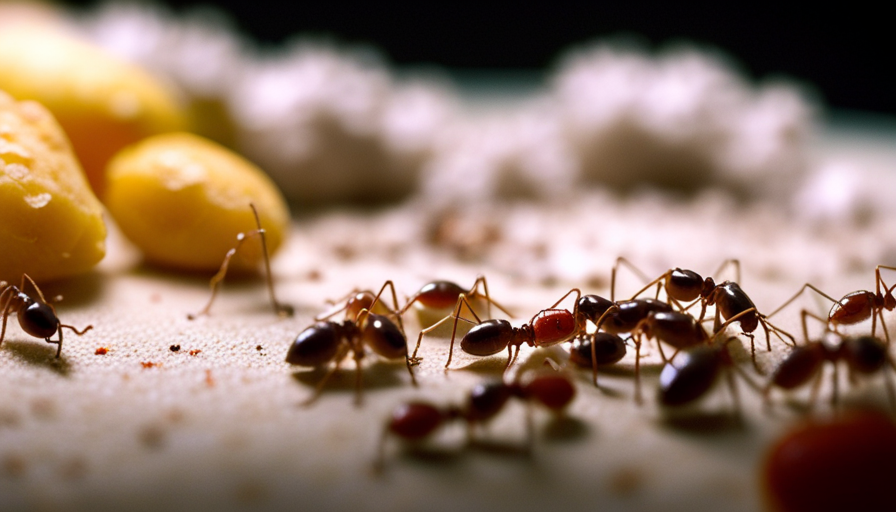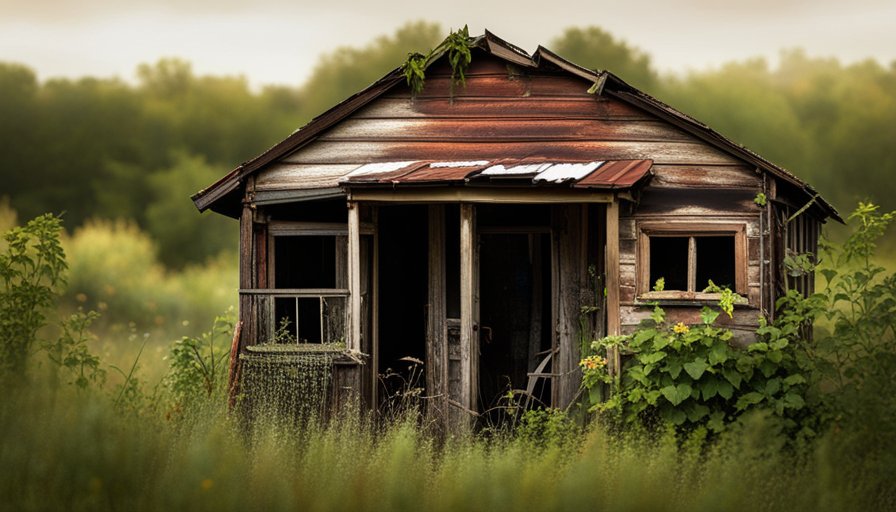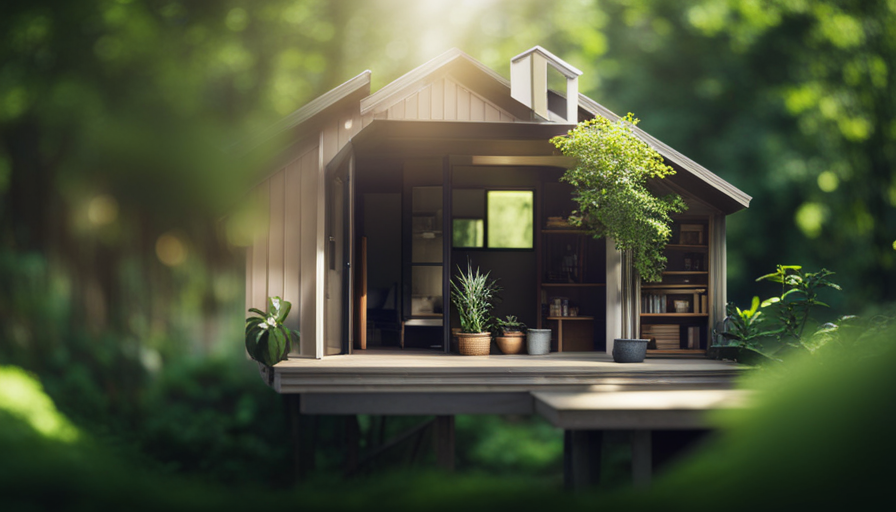It seems like these tiny ants have declared war on my house! They are all over the place, running around, sneaking into every small crack. But don’t worry, my fellow soldiers in the battle against ants, I have started a mission to get rid of these annoying intruders from my home. And now I’m here to share my findings with you.
First things first, we need to identify the ant species that have taken over our humble abodes. Are they pavement ants, odorous house ants, or maybe even carpenter ants? Once we know our enemy, we can devise a plan of attack.
Next, we must locate and eliminate the ant nest. These tiny creatures are master architects, building their colonies in the most inconspicuous places. But with a keen eye and a little persistence, we can put an end to their reign.
Sealing entry points is another crucial step in our battle against the tiny invaders. No more sneaky ant highways into our homes!
But wait, there’s more! Join me in exploring the world of natural repellents, creating barriers, and even calling in the big guns – professional exterminators.
So gather your courage, arm yourself with knowledge, and let’s banish these tiny ants from our homes once and for all!
Key Takeaways
- Identify the ant species causing the infestation by observing food preferences and tracking movement.
- Once ant species and nests are identified, they can be effectively eliminated using baits, traps, or insecticide dust/spray.
- Implement simple measures like sealing entry points, proper food storage, and regular cleaning routines to reduce the likelihood of ant infestations.
- Consider natural remedies like vinegar, lemon juice, cinnamon, or organic repellents as alternatives to insecticides.
Identify the Ant Species
If you’re wondering how to eliminate those pesky tiny ants invading your home, the first step is to identify the ant species causing the infestation. Understanding their behavior patterns is crucial in effectively getting rid of them.
Different ant species have unique characteristics that influence their nesting and foraging habits. Some ants prefer sweet foods, while others are attracted to protein-based substances. By observing their food preferences and tracking their movement, you can gain insights into their species.
Additionally, it’s important to locate ant colonies in and around your house. Look for visible signs such as ant trails, small mounds of soil, or discarded wings near windows or doors. Inside the house, check areas like kitchen cabinets, pantries, and bathroom corners. Outside, inspect the foundation, garden, or any cracks in the walls.
Once you have identified the ant species and located their nests, you can effectively eliminate them. Transitioning into the next section, we will discuss methods for locating and eliminating the ant nest without causing further infestation.
Locate and Eliminate the Ant Nest
To locate and eliminate the ant nest, I recommend using baits or traps. These can be strategically placed near areas where ants are frequently seen, enticing them to take the bait back to the nest and eliminating the entire colony.
Additionally, applying insecticide dust or spray directly to the nest entrance can be effective in eradicating the ants. It’s important to follow the instructions on the product labels and take necessary precautions to ensure safety and maximum efficacy.
Use Baits or Traps
When it comes to dealing with those pesky little ants infiltrating your home, one effective solution is using baits or traps to lure them away and eliminate the problem once and for all. Baits and traps are a great option because they not only target the ants you see, but also the entire colony.
There are various types of baits and traps available, including gel baits, liquid baits, and solid baits. These baits contain substances that attract ants, such as sweet or protein-based attractants, and are combined with a slow-acting poison. The ants take the bait back to their nest, where it is shared with the rest of the colony, effectively eliminating them.
Remember to place the baits or traps in areas where ants are commonly seen, and avoid using chemical-based options if you prefer natural remedies or ant prevention.
To take your ant control efforts to the next level, let’s move on to applying insecticide dust or spray.
Apply Insecticide Dust or Spray
Now, grab the insecticide dust or spray and start applying it in strategic areas throughout your home to effectively eliminate those pesky ants. Here are some discussion ideas to consider while applying the insecticide:
-
Safe alternatives to insecticide for ant control: Explore natural remedies such as vinegar, lemon juice, or cinnamon to repel ants without the use of chemicals.
-
The impact of ants on home gardens and how to manage them without insecticides: Ants can disrupt the growth of plants and protect pests like aphids. Consider using companion planting, sticky traps, or organic repellents to keep ants away from your garden.
Remember to follow the instructions on the insecticide label and take precautions to ensure the safety of children and pets. Once you’ve applied the insecticide, it’s important to also seal entry points to prevent ants from returning.
Seal Entry Points
Amidst the invasion of tiny ants, my house becomes a fortress with every entry point meticulously sealed. To effectively keep these persistent pests out, it is crucial to seal any cracks or gaps where ants can enter. By employing ant prevention techniques and sealing entry points, I can regain control over my home.
To visualize the importance of sealing entry points, consider the following table:
| Entry Point | Ant Activity |
|---|---|
| Cracks in walls | High |
| Gaps around windows | Medium |
| Gaps under doors | Low |
| Gaps in foundation | High |
Sealing these entry points not only prevents ants from entering my house but also disrupts their scent trails, making it harder for them to find their way back. This simple yet effective method significantly reduces the likelihood of future ant invasions.
Next, I will explore ways to keep my house clean and food secure, which complements the efforts of sealing entry points. Maintaining cleanliness and proper food storage are essential in preventing ants from being attracted to my home. By adopting these practices, I can further minimize the risk of ant infestations.
Keep Your House Clean and Food Secure
To keep my house free from tiny ants, it’s essential to store food in airtight containers. This prevents them from being attracted to food sources and eliminates their access to it.
Additionally, I must make it a habit to clean up spills and crumbs immediately to avoid giving them any reason to stay in my house. This ensures that their food supply is cut off, forcing them to look for sustenance elsewhere.
Store Food in Airtight Containers
One effective way to combat the invasion of tiny ants in your house is by storing food in airtight containers. Using airtight containers has numerous benefits for food storage.
Firstly, they create a barrier that prevents ants from accessing your food, as the containers are designed to be completely sealed. This helps to maintain the freshness and quality of your food, as it’s protected from moisture, air, and pests.
Additionally, airtight containers help to prevent spills and leaks, reducing the chances of attracting ants.
To maintain food freshness with airtight containers, it’s important to ensure that the containers are properly sealed after each use. This can be done by checking the lid for a tight fit and using containers made of durable materials.
By using airtight containers, you can effectively deter ants from accessing your food and keep it fresh for longer periods.
To further prevent ant infestations, it’s crucial to clean up spills and crumbs immediately.
Clean Up Spills and Crumbs Immediately
Right after a spill or crumb appears, make sure to clean it up immediately to prevent the onslaught of ants, just like swatting a fly before it lands on your food. Regular cleaning routines are essential in keeping ants at bay. These tiny creatures are attracted to even the smallest traces of food, and a clean environment will make it less likely for them to infest your home. In addition to cleaning, proper food storage plays a crucial role in preventing ant infestations. By storing food in airtight containers, you eliminate the enticing aroma that can attract ants. To illustrate the importance of these practices, consider the following comparison:
| Without Regular Cleaning Routines | With Regular Cleaning Routines |
|---|---|
| Ants easily find food sources | Ants struggle to find food sources |
| Increased risk of infestation | Decreased risk of infestation |
| Frequent presence of ants | Rare presence of ants |
By implementing these simple yet effective measures, you can significantly reduce the likelihood of ants invading your home. Now, let’s explore the next step: using natural repellents.
Use Natural Repellents
Hey there! Want to kick those pesky tiny ants out of your house? Try using natural repellents. When dealing with an ant infestation, it’s important to consider DIY ant repellent recipes, their effectiveness, and cost.
There are several alternative methods to repel ants naturally, without resorting to harmful chemicals. One popular DIY ant repellent recipe involves mixing equal parts water and white vinegar in a spray bottle. Ants dislike the strong scent of vinegar, making it an effective deterrent.
Another option is to sprinkle cinnamon or black pepper near entry points, as ants are repelled by these spices. Additionally, essential oils such as peppermint, lemon, or tea tree oil can be diluted with water and sprayed around the areas where ants are seen.
While these natural repellents can be effective, it’s important to note that their success may vary depending on the severity of the infestation. It’s also worth considering the cost of these ingredients compared to store-bought ant repellents.
Now that you have some natural repellent options, let’s move on to the next step: removing food and water sources.
Remove Food and Water Sources
To effectively eliminate those pesky little ants from your home, start by removing any accessible sources of food and water. Ants are attracted to these resources, so by eliminating them, you can significantly reduce the ant population in your house. Consider the following table for a comprehensive list of common food and water sources that may be attracting ants:
| Food Sources | Water Sources |
|---|---|
| Crumbs | Leaky pipes |
| Spilled liquids | Damp areas |
| Open food containers | Pet water bowls |
| Garbage cans | Potted plant saucers |
By diligently cleaning up spills, sealing food containers, and fixing leaks, you can make your home less appealing to ants. It’s also important to consider long-term solutions to keep ants away. Some alternative methods include using natural ant repellents such as cinnamon, vinegar, or citrus peels. These substances can deter ants from entering your home. Additionally, creating physical barriers by caulking cracks and sealing entry points can prevent ants from accessing your house altogether.
By removing food and water sources and considering alternative methods and long-term solutions, you can effectively get rid of those tiny ants. Now, let’s move on to the next step: creating barriers to keep ants out of your home.
Create Barriers
To effectively combat the tiny ant infestation in my house, it’s crucial to explore various strategies. After removing potential food and water sources, the next step is to create barriers that prevent the ants from accessing my living space.
By physically obstructing their entry points, I can significantly reduce their presence. One effective approach is to seal any cracks or crevices in the walls, floors, and windows using caulk or weatherstripping. This will deny the ants easy access and limit their ability to infiltrate my home.
Additionally, I can place barriers made from natural deterrents at key entry points. Substances like cinnamon, vinegar, or citrus peels act as strong repellents, deterring ants from crossing these boundaries. These natural remedies aren’t harmful to humans or pets, making them a safe and environmentally friendly option.
By incorporating these physical barriers and natural deterrents, I can actively discourage the tiny ants from infesting my living space. However, if the infestation persists despite my efforts, it may be time to seek professional assistance. A qualified exterminator can provide targeted treatments to eradicate the ants completely.
Call a Professional Exterminator
If the ant infestation persists despite your best efforts, it’s time to summon the cavalry and let a professional exterminator unleash their expertise. They have the knowledge and tools to effectively deal with the tiny ants that have invaded your home.
The first step in their process is to identify the ant species present in your house. Different species require different treatment methods, so it’s crucial to determine which type of ant you’re dealing with. Once the species is identified, the exterminator will then focus on locating and eliminating the ant nest. This is a crucial step because if the nest isn’t completely eradicated, the ants will continue to breed and invade your home.
The professional exterminator will use specialized products and techniques to ensure that the nest is completely destroyed. By calling a professional, you can rest assured that the ant infestation will be effectively addressed.
In the next section, we’ll explore steps to prevent future ant infestations.
To prevent future infestations, it’s important to take proactive measures to minimize attractants and entry points for ants.
Prevent Future Infestations
To prevent ants from invading your home again, you need to be proactive and take measures to minimize attractants and block their entry points.
There are DIY solutions for preventing future infestations, without using chemicals. One effective method is to keep your home clean and free of food debris. Ants are attracted to crumbs and spills, so make sure to wipe down surfaces and promptly clean up any spills. Additionally, store food in airtight containers to prevent ants from accessing it.
Another way to make your home less attractive to ants is to seal off their entry points. Use caulk to seal any cracks or gaps in windows, doors, and walls. You can also place barriers, such as cinnamon, citrus peels, or vinegar, near entry points to deter ants from coming inside.
Lastly, stay persistent and patient in your efforts to prevent future infestations. It may take some time and trial and error to find the most effective methods for your home. With consistent effort, you can keep ants at bay and enjoy an ant-free living space.
Stay Persistent and Patient
Stay persistent and patient in your efforts to keep your home ant-free, and you’ll soon see the results of your hard work paying off. Dealing with an ant infestation can be frustrating, but with determination and patience, you can successfully eliminate them from your house.
Here are four key strategies to help you stay persistent and be patient in your battle against tiny ants:
-
Identify entry points: Inspect your home thoroughly to locate where the ants are entering. Seal any cracks or gaps in windows, doors, and walls to prevent future infestations.
-
Maintain cleanliness: Keep your house clean and free of food debris. Ants are attracted to crumbs and spills, so regularly sweep and vacuum floors, wipe down countertops, and store food properly in airtight containers.
-
Use ant baits: Place ant baits strategically near ant trails and high-activity areas. Patience is crucial here, as it may take several days for the ants to carry the bait back to their colony, effectively eliminating the entire nest.
-
Regularly monitor and reapply treatments: Ants can be persistent, so it’s essential to stay vigilant. Continually check for signs of ant activity and reapply treatments as necessary to ensure long-term success.
Remember, it may take time to completely eliminate the ant infestation from your home. Stay persistent, be patient, and follow these strategies consistently, and you’ll soon enjoy an ant-free household.
Frequently Asked Questions
How do I determine the best method to get rid of tiny ants based on the ant species?
To determine the best method for getting rid of tiny ants based on their species, there are a few key methods to consider.
First, consult with a professional entomologist who can identify the ant species and provide tailored advice.
Additionally, you can use online resources or field guides to identify the ants yourself.
Once you know the species, research the most effective treatments specific to that type of ant.
To prevent ants from entering your house, maintain cleanliness, seal entry points, and use ant deterrents such as vinegar or cinnamon.
What are the signs that can help me locate the ant nest in my house?
To identify an ant nest in your house, look for signs of ant infestation. These signs include seeing a large number of ants in one area, especially near food sources. You may also find ant trails leading to and from a specific location.
Additionally, look for small piles of wood shavings, soil, or debris near cracks and crevices. These could indicate the presence of an ant nest.
Careful observation and monitoring will help in pinpointing the nest location for effective ant control.
How can I effectively seal entry points to prevent ants from entering my house?
To effectively seal entry points and prevent ants from entering your house, there are several sealing techniques and ant prevention methods you can employ.
Start by inspecting your home for any gaps, cracks, or openings that ants can use as entry points. Seal these openings using caulk or weatherstripping.
Additionally, ensure that windows and doors have tight-fitting screens and seals.
Regularly clean and maintain your home to eliminate food and water sources that may attract ants.
Are there any natural repellents that I can use to deter ants from coming into my home?
Natural ant repellents and homemade ant traps can be effective in deterring ants from entering your home. Some natural repellents include essential oils such as peppermint, lemon, and cinnamon, which can be mixed with water and sprayed around entry points.
Homemade ant traps can be made using a mixture of borax and sugar, which ants are attracted to but is toxic to them. By using these natural methods, you can deter ants from entering your home without the use of harmful chemicals.
When is it necessary to call a professional exterminator to deal with an ant infestation?
When is it necessary to hire an exterminator for an ant infestation?
It is important to consider professional help when the ant infestation becomes severe, persistent, or poses a threat to your health and safety. Professional exterminators have the expertise and specialized equipment to effectively eliminate the ant problem and prevent future infestations.
When selecting a professional, ensure they are licensed, experienced in ant control, and use environmentally friendly methods. Additionally, consider their reputation, customer reviews, and ask for a detailed treatment plan and cost estimate.
Conclusion
After following these steps to get rid of tiny ants in my house, I’m amazed at the results. It’s as if they vanished overnight!nnBy identifying the ant species, locating and eliminating their nest, sealing entry points, and keeping my house clean and food secure, I have successfully eradicated these pesky creatures.nnUsing natural repellents, creating barriers, and even calling a professional exterminator were also effective strategies.nnThe coincidence of all these strategies working together created a powerful force against the ant infestation, leaving my home ant-free and bringing me peace of mind.
Hi, I’m Emma. I’m the Editor in Chief of Tiny House 43, a blog all about tiny houses. While tree houses are often associated with childhood, they can be the perfect adult retreat. They offer a cozy space to relax and unwind, surrounded by nature. And since they’re typically built on stilts or raised platforms, they offer stunning views that traditional homes simply can’t match. If you’re looking for a unique and romantic getaway, a tree house tiny house might just be the perfect option.










